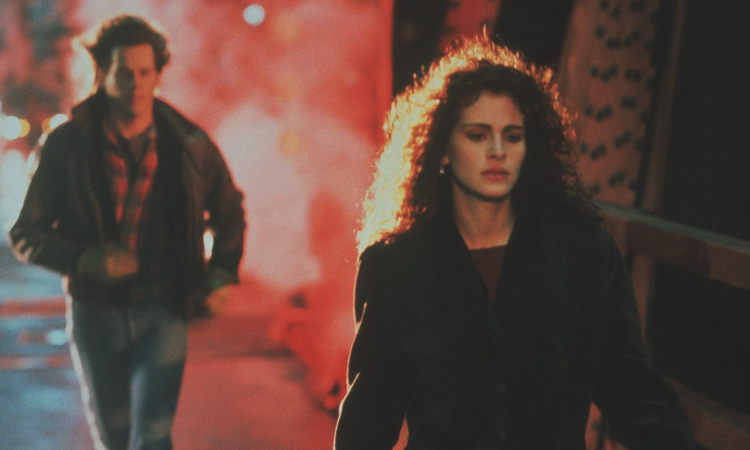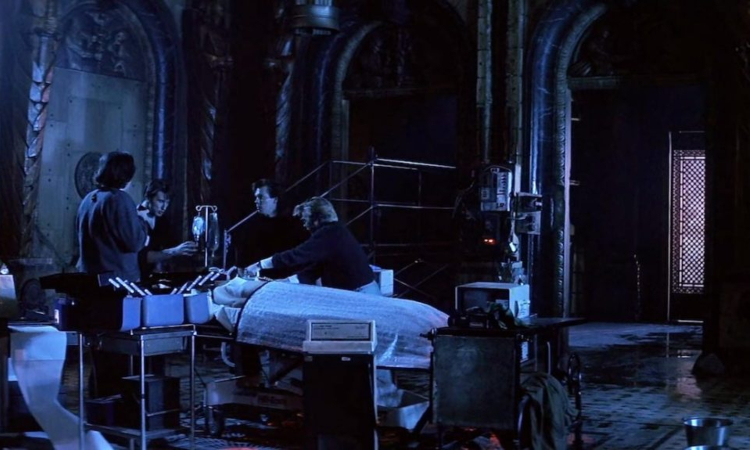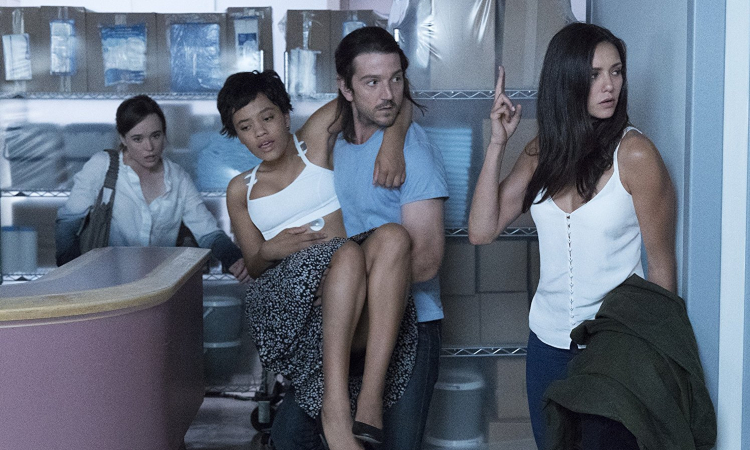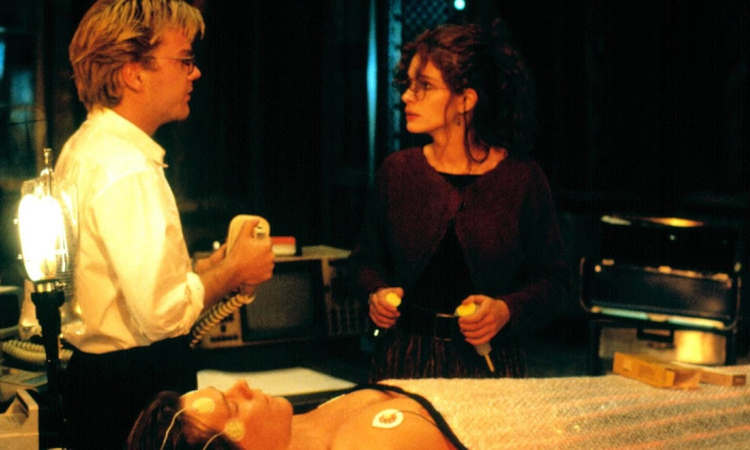Sometimes They Come Back is here to take a look at the horror genre and its love for remakes! We’ll be discussing both the original movie and its remake (sometimes multiple remakes) in detail before deciding who comes out on top! Are the originals always the best? Let’s find out!
While some movies get the remake treatment pretty quickly, some manage to avoid it for a long period of time, which just so happened to be the case for Joel Schumacher’s Flatliners (1990). Starring the cream of the acting crop way back at the start of the ’90s, Flatliners was a gothic horror hit that dealt with religion, past regrets, and morality.
Then, 27 years later, we were given a flashier and brightly-lit remake directed by Niels Arden Oplev, starring some of the hottest talent of the time including Elliot Page, Nina Dobrev, and James Norton. This time the focus was more on jump scares, A Nightmare on Elm Street-style (1984) dream sequences/near death experiences, and more of a demon focus.
But which movie is better? They both deal with death very differently, but they both star Kiefer Sutherland. Let’s take a deeper look at both of them and see what awaits us on the other side.
Flatliners (1990)

Nelson Wright is a medical student who is obsessed with understanding death. He comes face to face with death every day, and yet he has very little knowledge of what happens on the other side, and what is waiting for him. Nelson decides to convince a few of his fellow students to help him out with a little controlled death experiment, which will see Nelson die for one minute, and then be brought back to life, hopefully with a sneak preview of what awaits us when we leave this mortal coil.
Rachel, David, Joe, and Oliver are sceptical about the endeavour, worrying that their medical careers will be on the line if they’re found out or if Nelson dies during the experiment. However, they all eventually agree to participate. Nelson flatlines for a minute, and returns unharmed, talking of visions of his childhood while he was braindead. The fact that someone was waiting for Nelson on the other side makes the rest of his friends curious, with both Rachel and Joe desperate to be the next to participate, each wishing to push the time they are dead longer and longer to see if they can learn more than the person before them.
David is the most sceptical as an atheist, and he decides to go next as a sort of control for the experiment. He reasons that he’s not expecting to see something like the others, and therefore, if he experiences a similar sort of vision, it will prove the afterlife is real.

However, there’s something Nelson has been keeping from the rest of the group. While his vision during his flatline didn’t seem too disturbing, it turns out a little boy from his past, Billy Mahoney, has been returning in the real world to stalk Nelson, and even beating him up, leaving him with injuries everyone else can see as well.
The group soon figure out that their death visions show them things from their past which they regret. David, perhaps being the most logical of the group due to him not believing in the afterlife, figures out that dealing with this past trauma and healing with those involved allows them to move past these regrets.
Nelson is struggling to deal with the mistakes he’s made in his past the most, believing he’s already atoned for what he’s done wrong. While the others work through their problems and shed their hauntings, Nelson is the one left dealing with the full consequences of his experiment, and wanting to know what awaits us after we die.
However, thanks to some help from his friends, and his willingness to risk his own life to finally apologise in the way he needs to, he’s able to make it back to the world of the living, hopefully a little more optimistic about what the afterlife will bring when it’s actually his time.
Flatliners (2017)

In the 2017 remake, it is medical student Courtney who decides to take a step into the afterlife to see what is waiting for her. After the death of her younger sister in a car accident where Courtney was driving, she is determined to find out what is waiting after we pass, perhaps to learn more about whether her sister is waiting for her on another plane of existence.
Initially, she only invites fellow students Sophia and Jamie, but when they struggle to bring Courtney back to life after the required amount of time, Ray and Marlo end up getting involved as well. These students are competitive, constantly having to prove themselves in the classroom, the hospital, and in front of each other, and so it’s no surprise that they quickly turn dying into a competition.
Eventually, the students start to find themselves literally haunted by visions of their past sins. But they also find their brains almost rewired, as Courtney starts to perform better at school, and remembers how to do things such as bake bread and play the piano. The buzz that comes with dying and returning to life almost seems like a drug for them, with the group partying as they celebrate their survival and their new selves.

However, when Courtney dies after being attacked by a demonic version of her little sister, the group soon realises they have brought something back with them from the afterlife. And unless they are able to make up for their past mistakes, it will kill them all in revenge.
Luckily most of the friend group are able to track down those from their past and apologise to them. However, as Marlo’s mistake cost a patient his life, she’s finding it harder to get the closure she needs. But with a little help from ghost Courtney, she learns that the most important thing is learning to forgive herself for what happened, which is hopefully what Courtney has done over his sister’s death.
In the end, the group are bonded much closer as friends and feel more comfortable in themselves now that they have owned up to their past mistakes. Though Courtney is psychically missing, there are hints that she’s still there, and at peace along with her friends.
Flatliners (1990) vs Flatliners (2017) – The Final Verdict
The Medical Students

In both versions of the story, the groups of medical students involved aren’t portrayed as fast friends from the beginning, but their situation ends up bonding them together. Medical school is a competitive place, so while they’re all aware of each other, they don’t necessarily seem to hang out much outside of the classroom.
In 1990, Nelson and the rest of the men in the group seem quite close. They’re all aware of Joe’s habit of having sex with multiple women and recording it, so there must be a level of familiarity there. However, they mostly seem to admire Rachel from afar, partly for her medical ability but also due to her extreme beauty. Even though Rachel is used to batting off their romantic advances, she becomes the most caring member of the group, usually being the one who stays behind to ensure that those who flatlined survive through the night.
However, she also struggles to be seen as equal within the group. Nelson admits that the experiments wouldn’t be possible without her expertise, and yet, she is passed over again and again when she volunteers to go next. Even though she’s recognised as an extremely talented doctor, the men let their sexism show a little by wanting to protect her more than they do their fellow friends. David is the most insistent she doesn’t take part, because of his underlying love for her.
The group is even more disconnected in 2017. Courtney has been close friends in the past with Sophia, but they have drifted apart due to the pressures of medical school. Meanwhile, Marlo and Ray are rivals, constantly bickering with each other before it turns out they’ve been flirting the whole time.
They are pulled together as a group because of the experiences with flatlining, and the highs and partying they experience afterwards. And it’s fair to say that they are brought even closer because of Courtney’s death, with the group actively hanging out at the end of the film, bonding in their shared experience.
However, I think the group from the 1990 film feel a lot more genuine. Nelson spent time figuring out exactly who he wanted involved, with each person bringing a different area of expertise to the group. The experiment only works when they are all together, and they build up their trust in each other and the process the more times they participate. They were friends before but their bond grows stronger, and the relationship that blossoms between Rachel and David feels real and natural.
The friends recognise Nelson’s flaws, which only get worse the deeper into the experiment they go, but they fight to save him, hoping that he will receive the atonement the rest of them have achieved to guarantee them peace.
However, Marlo’s solo flatline at the end of the 2017 movie doesn’t have the same punch to it, with Ray leading the charge to save her purely because of their romantic involvement. There’s also the fact that this group chooses to do their flatlining sessions in the basement of the hospital, meaning the risk of getting caught is far greater.
The Visions

The way that both versions of Flatliners differ the most is in the visions the medical students have both when they are flatlining and in the real world after they’ve returned from the dead. For the 1990 crew, the visions they experience while flatlining are mostly just memories of things that have already happened to them. There’s sometimes an altered colour palette or some slow-motion shots, but mostly those flatlining are just reliving their past.
Afterwards, when they’re back in the real world, the visions are unsettling because they sneak up on them when they’re least expecting it. David sees a young girl he used to bully on a train, and she shouts insults at him as no one else in the carriage reacts. Joe sees the women he’s slept with and filmed chastising him as he walks down the street. Rachel’s dead father appears to her while she’s operating on a cadaver at medical school. But the visions themselves aren’t inherently creepy. They’re strange because they shouldn’t be there, and because only the individual can see them, leaving them feeling scared and isolated.
In the 2017 movie, however, the flatlining visions are used for jump scares and adding some creepiness to the proceedings. The medical students are haunted by horrible, twisted versions of their past sins whether those involved are dead or not. As I mentioned in the intro, they all feel like something that would be very at home in A Nightmare on Elm Street.
Courtney is haunted so much by the scary version of her little sister that she is pushed off her apartment’s balcony and dies. Jamie is stabbed in the hand by a ghostly vision of his ex-girlfriend after hearing a baby crying in his boat. Marlo is stalked around the hospital morgue by the dead body of a patient whose death she was involved in. These visions are meant to scare both the audience and those involved.
There is so much focus on these visions and the associated scares that we spend far more time viewing these visions than we do focusing on the experience of flatlining itself. The 1990 version, however, gives more time to the multiple flatlining sessions, as we build up to the more intense visions such as Rachel’s father or the growing violence of Nelson’s encounters with Billy Mahoney.
Past Sins and Guilt

For Flatliners (1990), the discussion of life after death is very much placed under the umbrella of religion and morality. Rachel regularly quizzes her patients on the existence of the afterlife. David is the control participant because he’s an atheist, believing the others are only experienced visions of the afterlife because that’s what they so desperately want to believe will happen when they die.
The things they experience are not necessarily past sins, but more regrets which they have to face head-on in the afterlife. These are the regrets they would have if they died right now, and dying makes them realise that they need to settle these matters in order to be able to move on. For Joe this means his fiance finding out about his videotaping habit. David apologises to the schoolmate he bullied as a child. Rachel finally makes peace with her father, with him apologising to her making her finally release the guilt she felt over his death.
For Nelson, even though he believes he’s been punished enough after being sent to a reform school as a child, it’s clear the guilt is still eating him alive. We see him have increasingly violent encounters with Billy, but we eventually discover that the visions of Billy were solely in Nelson’s mind, and he’s been injuring himself as his guilt grows stronger. It takes him much longer to realise he needs to apologise than the others, but a prolonged flatlining session where he puts himself in Billy’s shoes and finally says sorry gives him the closure he needs to move past it all.
Religious imagery is also rife in the 1990 film, with the flatlining sessions taking place in a church under renovation. The music in the opening scenes is an angelic chorus that would suit any other religious horror movie. It’s clear that religion is at the core of Flatliners, and whether you believe in something or not, thoughts of the afterlife are something we all wonder about from time to time.
In the 2017 movie, the whole thing is a little more confusing. There’s no chat of religion, and the main driving force for the flatlining experiment is Courtney wanting to find out what is waiting for them, and therefore, what has happened to her younger sister.
The regrets are more obvious sins this time around, with each of the students having done something truly horrible in their past which they need to atone for. For them, their medical careers are all-consuming, and so they don’t have time to think about the pregnant girlfriend they abandoned, the nude pictures they leaked, or the patient they accidentally killed.
This time around, there’s the suggestion that when they dabbled in death, they brought something back with them. Courtney is pushed off her balcony by something pretending to be her sister, and while they later suggest that it’s merely their guilt that’s causing them to be haunted, situations such as Courtney’s death lean more into the demon/scary entity side of things. Whereas the 1990 film was very clear with what was going on when it came to the visions, and 2017 muddles things to the point where I’m not sure if it was paranormal or simply guilt running wild again.
Who Wins?

Overall, Flatliners (2017) feels like one of those movies that is packed with jump scares and twisted faces for the sake of getting as many scares out of the audience as possible. However, there are very few situations where these scares feel genuine.
The 1990 movie, on the other hand, leans into the unsettling and unknown nature of death and the afterlife in general. It’s not about making the vision scenes scary, but more about trying to figure out what is going on and how it can be fixed.
This movie is dark, shadowy, and steeped in religious undertones that make for a beautiful piece of cinema. The remake, however, is full of white and overly-bright scenes, which mark it as very different from its predecessor. The scares don’t land, the characters aren’t as likeable, and it is missing the wonder of Julia Roberts and her amazing ’90s hair and glasses combo.
Winner: Flatliners (1990)

Why not check out more editions of Sometimes They Come Back here!

